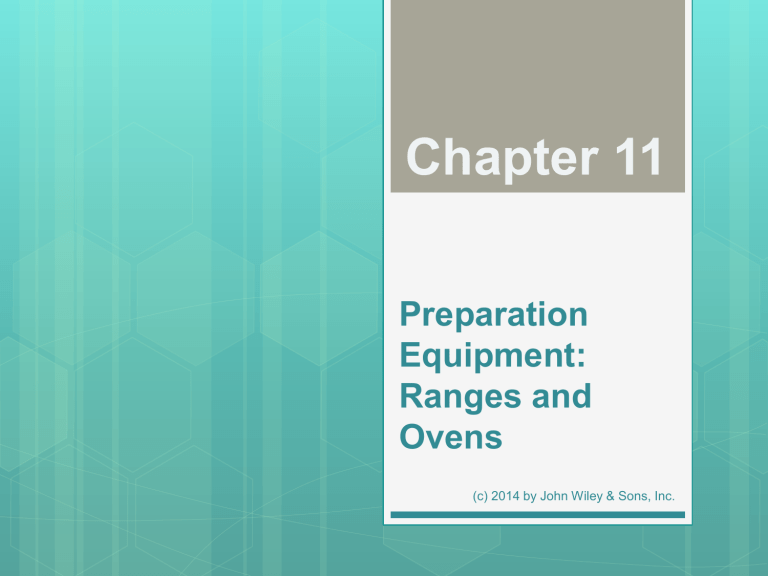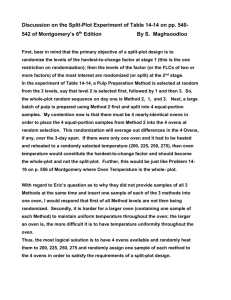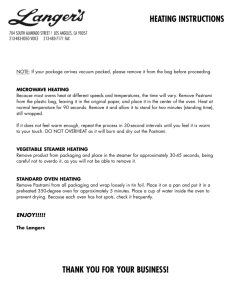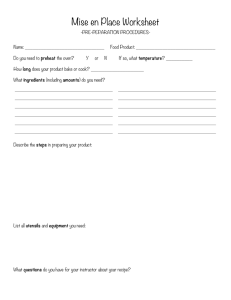Principles of Kitchen Design

Chapter 11
Preparation
Equipment:
Ranges and
Ovens
(c) 2014 by John Wiley & Sons, Inc.
Learning Objectives
In this chapter, you will learn to:
Identify the types of ranges and ovens available in foodservice, including custom models and options for certain types of cooking.
Identify the sizes and utility requirements of ranges and ovens.
Describe the basics of range and oven selection and purchasing.
Explain cleaning and maintenance tips.
(c) 2014 by John Wiley & Sons, Inc.
Selecting Cooking Appliances
For range/oven purchase, consider…
Power requirements.
What load can your kitchen safely handle?
Are there installation costs for this energy source?
Energy efficiency.
How much power or gas does it use? How well is the oven cabinet insulated?
Menu.
Batch cooking, or made-to-order? How are the foods you want to serve most efficiently prepared?
Quantity.
How much food is needed at peak times? What can be prepared in advance?
Speed.
Is slow-cooking necessary, or out of the question? Is higher-temp cooking or microwave use acceptable for some menu items?
Space available.
Where will it fit – with adequate room for ventilation?
Type of space.
Will appliances be seen in use by the public?
(c) 2014 by John Wiley & Sons, Inc.
Selecting Cooking Appliances
For range/oven purchase, consider…
Other appliances.
Are alternatives available for certain cooking duties: steam kettles, steamers, griddles, broilers, fryers, etc.?
Overall number.
How many ranges are needed? General rule in restaurants is one range for every 50 seats. The size of the appliance (how many burners, etc.) is a factor.
Staff skill levels.
High turnover or complexity of recipes? Will anyone be able to program automated functions – or can they learn?
Holding space.
There should be sufficient room on rangetops for holding some foods hot in pots and pans during busy times.
(c) 2014 by John Wiley & Sons, Inc.
Basic Principles of Heat
Conduction
Simplest form of heat transfer – heat moves directly from one item to another with direct contact
Induction
Convection
Heat is created when an electromagnetic field is created between rangetop and pan.
(Pan must be made of ferrous metal to prompt this reaction.) Burner stays cool to the touch.
Heat is distributed by moving air, steam or liquid. Cooks quickly and evenly because the heat penetrates food faster.
Infrared and microwave radiation are two types of convection cooking.
(c) 2014 by John Wiley & Sons, Inc.
Types of Ranges (Gas)
Mediumduty or café range
For smaller foodservice operations with short-order menus
Six 6 to 10 burners, 12" square, at 20,000 Btu each
Can be ordered with one or two ovens, or a refrigerator, beneath
Back wall can be a high shelf or 5inch “stub” just to prevent spatters
Can be put on casters to move more easily for cleaning or repair
Heavy-duty range
For long hours and high-volume cooking. Made of heavier materials than the café range
Four burners, 12" or 18" square, at 30,000 Btu each
Seven-inch stainless steel shelf in front of burners
Optional storage shelves mounted at back of range, on the flue
(c) 2014 by John Wiley & Sons, Inc.
The Rangetop
©John Wiley & Sons, Inc.
(c) 2014 by John Wiley & Sons, Inc.
Specialty Ranges
Tabletop range.
A compact model with two, 12" burners for use where space is tight.
Taco range. Pans and pressure cookers fit into its recessed burners, so that a Mexican restaurant can prepare meats, rice and beans simultaneously.
Wok range. Burners are circular, recessed and adjustable to fit woks of different sizes for stir-frying. High heat, up to
106,000 Btus. Optional accessories: removable trays, shelves for spices, built-in water faucet.
Stockpot range (pictured). Large, open burners for heating large stockpots. Heating capacity 55,000 Btus. Also used in bakeries for melting chocolate in large quantities.
(c) 2014 by John Wiley & Sons, Inc.
Electric Rangetops
Power requirements are critical details.
Electric range is 208-240 volts, one-phase or threephase
Compatibility of voltage and phase must be determined to avoid expensive modifications to power supply later
Medium-duty size is 30" square; heavy-duty 36" square
Coil-type or solid burners
Rectangular hotplate
French hotplate
High-speed surface unit
Electric induction rangetop surface is smooth, tempered ceramic or glass. Energy-efficient, does not heat up kitchen, requires less ventilation than other ranges – but still must be located under hood. Portable models available.
(c) 2014 by John Wiley & Sons, Inc.
The Range Oven
When selecting an oven, consider…
Infinite-heat controls.
More precise than the old ‘lowmediumhigh’ knobs. Can have controls mounted on side of oven instead of at front so they are not bumped easily.
Insulation.
At least 2" of rock-wool insulation is recommended. An insulated handle also stays cooler.
Oven deck.
Made of at least 14-gauge steel, with raised sides and back to catch spatters.
Ease of cleaning.
Self-cleaning cycle for oven; easyto-clean surfaces. Some oven decks can be removed for cleaning
Legs. Adjustable legs can be leveled; locking casters are another good option.
(c) 2014 by John Wiley & Sons, Inc.
Convection Ovens
For convection ovens, consider…
Matching pan size to oven size.
This oven’s precise airflow pattern makes the correct pan size important to ensure proper air circulation during cooking.
A two-speed fan.
Lower air velocity is good for slower cooking or more delicate products.
One door or two?
Can open from sides, or from top (like a conventional oven).
Power source.
Some chefs think electric convection ovens yield a moister product than gas. Portable, propane-powered ovens also are available.
Adding steam.
A steam option for the convection oven makes for a more versatile appliance.
(c) 2014 by John Wiley & Sons, Inc.
Other Oven Types
Deck oven or stack oven
Food can be set directly on the (stainless steel or ceramic) deck or floor of oven cavity, or on oven racks. These appliances are stackable, hence the “stack oven” name.
Electric models have two sets of heating elements, at top and bottom.
For multiple ovens, more insulation is recommended.
Types of deck ovens include:
Traditional.
Cabinet is 8" high for baking or 12" high for roasting.
Motorized convective.
Three horizontal baking hearths.
Vaulted.
A larger, arched opening for easy access
Turntable.
Tallest oven (6 ft.+) with 3 or 4 rotating, circular baking decks.
(c) 2014 by John Wiley & Sons, Inc.
Other Oven Types
Cook-and-hold oven
Uses radiant and convection heat for slow-cooking, even overnight
Excellent for reheating large amounts of cooked food
Temperature range is from 140º to 245º F.
Can order tabletop model with carving station on top for buffet lines
No special ventilation requirements
Wood-fired oven
Wood burned to generate heat; retained within 4" thick stone blocks or bricks.
Mostly gasfired (“gas-assist”) models are used because of fire code restrictions
The more thermal head space (height of oven cavity), the better it holds heat
High temps (to 700º F.) perfect for roasting, caramelizing
(c) 2014 by John Wiley & Sons, Inc.
Other Oven Types
Specialized ovens for specialized cooking needs
Impinger/conveyor – The speed of impingement cooking with an adjustablespeed conveyor belt for timing the process. Very energy-efficient.
Pizza oven – A high-temp deck or stack oven with a short oven cavity and deck (ceramic or steel) perfect for baking pizza.
Mechanical oven – A revolving or rotary oven in which the food is in motion
(merry-goround style) while it’s being cooked. For high-volume operations.
Rack oven – A tall, thin oven chamber into which full baking racks of product can be rolled for baking. Options are steam and its own built-in hood.
Smoker-cooker – A commercial version of the popular meat-smoker.
Electric cookers eliminate the need to watch and stoke a fire.
Rotisserie – Small electric motors rotate spits (metal spikes) or hanging baskets where meats are placed for roasting. Attractive, if they are kept clean.
(c) 2014 by John Wiley & Sons, Inc.
Microwave Ovens
The microwave is not just for retherming! It can:
Bake potatoes quickly
Steam or poach fish, vegetables
Safely defrost frozen foods
Wattage = cooking speed. For retherm, get at least
1000 watts. For defrosting or large quantities, 1400 to
2700 watt units are preferable.
Use in tandem with other appliances to keep kitchen cool. Start foods in microwave, finish on rangetop, etc.
Homeuse microwaves aren’t allowed in foodservice.
(c) 2014 by John Wiley & Sons, Inc.
Ovens for Bakeries
Bakeries have special oven needs
Rack ovens work well for high-volume output
Deck ovens work well for bread-baking
Steam tube ovens are a wood-fired alternative
Proofers are heated, humidified cabinets to warm dough and start the rising process
Retarders chill dough to stop the rising process
There are combination proofer/retarders, and also oven/proofers.
(c) 2014 by John Wiley & Sons, Inc.
Cleaning and Maintenance
Take good care of your appliances
Clean stainless steel surfaces regularly.
Rub gently – don’t scrape – to prevent scratches that would eventually cause rust.
Check range and oven burner ports, vents, filters, cooling fans to ensure they are not blocked or clogged. Remove crumbs, grease, baked-on foods.
Wipe out microwave interior daily; clean spatter shield on ceiling weekly.
Overall, be observant – and train your staff to do the same. Take care of small maintenance issues before they become big ones, to protect these major equipment investments.
(c) 2014 by John Wiley & Sons, Inc.




